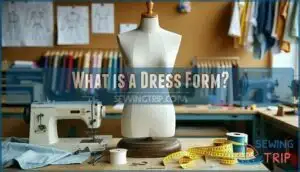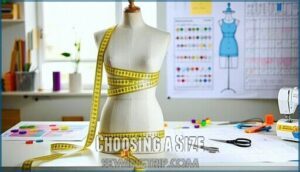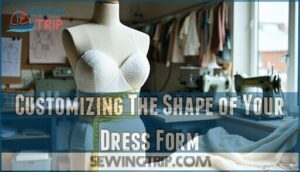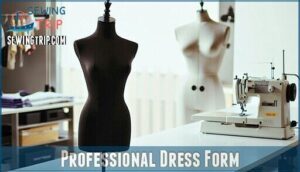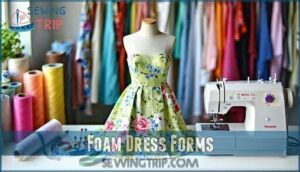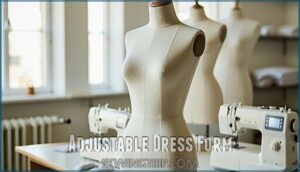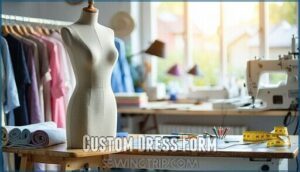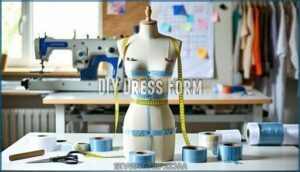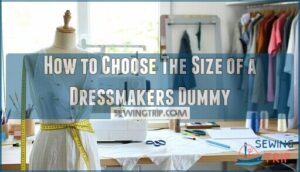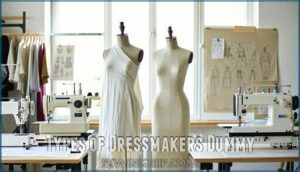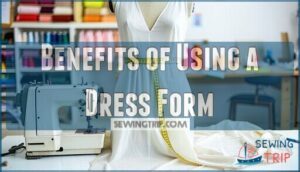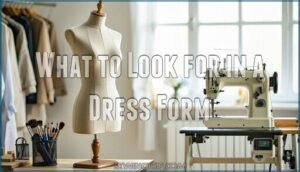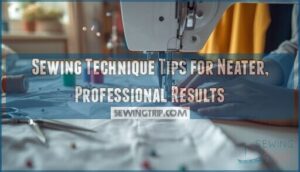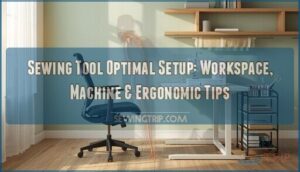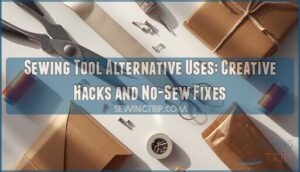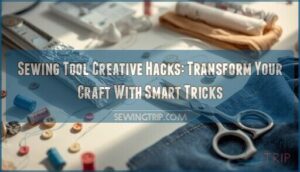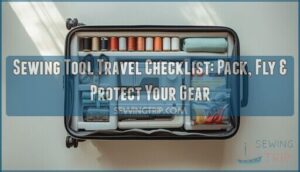This site is supported by our readers. We may earn a commission, at no cost to you, if you purchase through links.
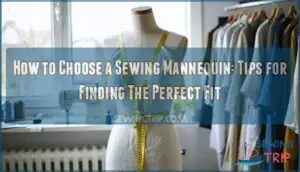 Choosing the right sewing mannequin starts with your needs.
Choosing the right sewing mannequin starts with your needs.
First, match its size to your body or the garments you’ll make—bust, waist, and hip measurements are key.
Adjustable mannequins offer flexibility for growing projects, while fixed forms are great for precision.
If you’re after a custom fit, consider padding a basic mannequin or even making a DIY version.
Look for sturdy materials, an adjustable height, and a stable base—no one wants a mannequin that wobbles mid-project.
Think of it as your sewing assistant—it should complement your skills and style.
And don’t forget, the type of mannequin can shape your results!
Table Of Contents
- Key Takeaways
- What is a Dress Form?
- Choosing a Size
- Customizing The Shape of Your Dress Form
- Types of Dress Forms
- How to Choose The Size of a Dressmakers Dummy
- What is The Best Dressmakers Dummy to Buy?
- Types of Dressmakers Dummy
- Benefits of Using a Dress Form
- What to Look for in a Dress Form
- How to Assemble a Dress Form
- Frequently Asked Questions (FAQs)
- Conclusion
Key Takeaways
- Match the mannequin’s size to your body measurements, focusing on bust, waist, and hip dimensions for accurate fitting.
- Choose between adjustable, fixed, or custom forms based on your flexibility, project needs, and skill level.
- Look for essential features like stability, height adjustability, and a pinnable surface to ensure ease of use and precision.
- Consider padding or DIY customization to tweak the form for a perfect and personal fit.
What is a Dress Form?
A dress form, or sewing mannequin, is a must-have for tailoring precision. These tools replicate body shapes, making garment fitting a breeze.
A dress form is every sewist’s secret weapon, offering precision and ease for crafting perfectly tailored garments effortlessly.
Made with foam, fabric covers, and adjustable parts, they help you craft perfectly sized clothing. Whether it’s a professional dressmaking mannequin or an adjustable mannequin, each supports core functions like hemming, pattern drafting, or pinning.
Introduced long ago, these tailors’ dummies meet modern industry standards. Adjustable options allow fine-tuning for body measurements—essential for accurate dress form construction and custom creations.
Choosing a Size
Choosing the right sewing mannequin starts with accurate measurements.
Here’s how you can pick the perfect mannequin size:
- Use ASTM charts to match your body measurements, including bust, waist, and hips.
- Look for features like height adjustability and expandable dials for precise fits.
- Consider padding kits to adjust the form for custom sizes, adding up to 3.5 inches.
- Prioritize portability features like lightweight stands or compact designs for easy setup.
A reliable sizing guide guarantees your dress form size fits every project perfectly.
Customizing The Shape of Your Dress Form
Not everyone’s body matches a standard dress form, but that’s where customization works wonders.
Start with padding techniques to match your body shape—foam padding helps fill out areas like hips or bust. Need torso lengthening? Add layers near the waistline for accuracy.
Adjustable settings often allow fine-tuning for posture correction, ensuring garments drape naturally. Shoulder adjustments are simple with collapsible or foam-filled shoulders, perfect for fitted sleeves.
For even more precision, focus on fabric manipulation, like pinning a snug cover over padding to hold everything in place. A foam-backed surface lets pins stay secure as you test designs.
Dress form customization isn’t just tweaks; it’s tailoring your mannequin as close to your body as possible for a professional fit every time.
Types of Dress Forms
When choosing a dress form, it’s important to know the different types available and what they’re best for.
From adjustable forms to custom-made options, each type offers unique benefits depending on your sewing needs.
Professional Dress Form
A professional dress form is every designer’s trusted ally, combining industrial durability with advanced features that make garment crafting a breeze.
Designed for alteration precision, these forms replicate body dimensions with exceptional accuracy, making them ideal for projects that demand a perfect fit. They’re built to last, often featuring high-quality materials like foam, fiberglass, or fabric-covered torsos.
When it comes to dress form adjustability, options like collapsible shoulders and adjustable heights accommodate diverse garments and workspaces. Designer preferences often lean toward models with rolling bases for ease of movement and built-in cushion layers for secure pinning.
Exploring options for a reliable dress form can greatly enhance the sewing experience. Although the investment justification may feel significant, the unmatched dress form quality guarantees years of reliable use. It’s simply a must-have for serious sewists.
Foam Dress Forms
Foam dress forms are a versatile choice for tailoring garments. Their lightweight design guarantees easy handling, while the foam density balances between durability and pinning ease.
Whether you’re hemming a skirt or sculpting techniques for a fitted jacket, these forms provide consistent support to get the job done right. They’re particularly handy for sewists of all levels, offering an affordable option compared to other types like a professional or adjustable dress form.
However, durability concerns can arise with prolonged use, especially if exposed to wear and tear. Many users find the perfect foam dress form for their sewing needs.
Despite this, foam dress forms remain cost-effective, making them a smart addition for perfecting your sewing projects. Their features help boost your confidence, one stitch at a time, and are a great tool for sewing projects and providing consistent support.
Adjustable Dress Form
An adjustable dress form is a must-have for fine-tuning garment fits.
With dial systems, you can tweak torso length, shoulder adjustment, and other areas effortlessly. Collapsible shoulders simplify garment removal, while adjustability mechanisms cater to versatile sizing.
Many dress form features, like foam-backed surfaces, make pinning easy. An excellent choice is an adjustable sewing mannequin.
Although lightweight stands improve portability, stability may vary. Use padding to refine your sewing mannequin for more precision during draping and garment construction.
Custom Dress Form
A custom dress form is like having a body double for creating perfectly fitted garments.
Having a custom dress form feels like working with a perfect replica, ensuring every garment fits flawlessly.
Designed to match your exact body measurements, it guarantees precision for dressmaking and adjustments. These molded forms come in styles like professional-grade or DIY dress forms. Features like personalized mannequins with foam padding or 3D printing boost accuracy.
- Body Specificity: It mirrors your shape for spot-on fit.
- Versatility: Add features like collapsible shoulders or height adjustability.
- Creative Solutions: DIY padding provides budget-friendly options.
Whether for everyday sewing or high-fashion projects, a custom dress form transforms your creative vision into reality with unmatched precision.
DIY Dress Form
If you’re looking for an inexpensive option that mirrors your exact measurements, a DIY dress form is the way to go.
Using duct tape, torso padding, and basic tools, you can create a body double that reflects your shape with impressive accuracy.
This project is fun, budget-friendly, and guarantees accurate sewing measurements.
With shape accuracy made to fit you, it’s a practical way to elevate your garment-fitting process without breaking the bank!
How to Choose The Size of a Dressmakers Dummy
Choosing the right size of a dressmakers dummy is all about precision. Start by comparing your body measurements to dress form measurements. Don’t rely on clothing sizes—they often vary. Use ASTM charts for a reliable size range. Picking a form slightly smaller than your body is a smart move since you can pad it for the perfect fit.
Look for these essential features when narrowing down your choice:
- Height adjustability: Guarantees the form matches your proportions.
- Fabric options and padding kits: Useful for adding layers to mimic your exact shape.
- Portability features: Handy if you need to move your dummy around your workspace.
The goal? A dress form that complements your sewing needs while staying flexible enough for adjustments!
What is The Best Dressmakers Dummy to Buy?
Finding the best dressmakers dummy depends on your budget, sewing needs, and the features you value most.
If you want a fitting mannequin with flexibility, the Female Adjustable Dressmakers Dummy offers 12 adjusters, making it great for various sizes.
For those focused on material quality and tackling lingerie or corset projects, the Royal Dress Forms Penelope stands out for its adjustability, though it’s pricier at $200–$500.
Budget-conscious beginners might appreciate The Shop Company’s 3/4 Body Miniform, costing just $139 while saving storage space.
Comparing brands for quality and stability is key, as is considering storage solutions for smaller setups.
Look for reliable brands like Valentino that balance price and quality.
You’ll find the right mannequin for sewing by analyzing your needs carefully.
Types of Dressmakers Dummy
When choosing a dressmaker’s dummy, it’s important to know the different types available and their purposes.
From fixed forms to professional models, each option suits specific sewing needs and offers unique features.
Fixed Dressmakers Dummy
A fixed dressmaker’s dummy is a go-to choice if you’re aiming for precision and durability. Unlike adjustable forms, fixed dress forms have set measurements that can’t be altered. This makes them perfect for consistent results when fitting or hemming garments.
While they trade flexibility for precision, their sturdy build guarantees long-term reliability. Here’s what makes a fixed dummy stand out:
- Durability comparison: Solid construction withstands heavy use.
- Material choices: Most come with fabric covers to protect garments from pin damage.
- Cost analysis: Often more affordable than some adjustable options.
- Alteration limitations: Fixed sizes mean it’s essential to select the correct size for your needs.
- Ideal projects: Great for creating custom dresses or outfits with precise fitting.
Whether for professional or hobby use, a fixed dress form guarantees dependable results.
Professional Dressmakers Dummy
If you’re ready to up your sewing game, a professional dressmakers dummy might be your perfect match.
These high-quality tools offer industrial durability, making them ideal for frequent use and long-term projects.
Designed for precision measurements, they allow you to achieve impeccable garment fitting with advanced adjustments.
A professional dress form often features fabric compatibility, meaning it can mimic how different materials will behave when crafted.
Plus, many are built with steam resistance, so you can press fabrics directly without worrying about damage.
Whether adding darts, shaping pleats, or refining a hemline, this dressmakers dummy guarantees every detail is spot on.
For serious sewists, it’s a reliable partner that takes your tailoring and design skills to the next level.
Benefits of Using a Dress Form
A dress form is a game-changer for sewing.
It allows garment visualization by showing how pieces will look while saving time through precise measurement accuracy.
With pinning ease, you can secure fabric effortlessly, and sewing efficiency gets a boost as adjustments can be made directly on the form.
For presentation enhancement, finished pieces shine on a mannequin that mimics real body shapes.
Adjustable dress forms offer flexibility with measurement dials.
Whether you’re perfecting a hem or designing from scratch, the benefits of dress form selection are too valuable to ignore, making it a crucial tool for achieving sewing efficiency and precise measurement accuracy with pinning ease.
What to Look for in a Dress Form
When picking a mannequin for sewing, focus on form stability, portability options, and cover material.
A stable base prevents tipping, while wheels add mobility.
Look for a fabric-covered, pinnable surface to safeguard fabrics during sewing.
Adjustable dress forms with dials allow size tweaks to match your body measurements.
For dress form adjustability, pick one slightly smaller than your size and pad to fit.
Creating your own dress form, however, allows for a perfect custom fit.
There are many dress form types, so match your choice to your sewing needs for the best results, considering the importance of a perfect custom fit.
How to Assemble a Dress Form
Assembling a dress form doesn’t have to be tricky if you follow a clear process. Start by securing the stand attachment to guarantee stability. Next, connect the torso using precise alignment for proper balance. Smoothly install the fabric cover to avoid wrinkles, especially for delicate materials.
Troubleshoot any issues like loose fittings or wobbling as you go. One can also make your own to save money.
- Check adjustable dials for accurate measurements.
- Attach foam padding snugly for a better fit.
- Confirm height adjustability for versatility.
- Verify stability to prevent tipping during use.
Frequently Asked Questions (FAQs)
What should I look for in a dressmakers dummy?
Look for a dressmaker’s dummy with adjustable sizing, sturdy construction, and good fabric for pinning.
Verify it matches your body measurements and sewing needs.
Stability, portability, and easy height adjustments are also key.
How to size a sewing mannequin?
Think of fitting a mannequin like tailoring a shadow to match your form.
Measure your bust, waist, and hips carefully.
Aim slightly smaller; padding can perfect the fit for sewing precision and versatility.
What can I use instead of a sewing mannequin?
You can use a padded dress form, sturdy foam board, or even yourself as a base for fitting.
Wrap yourself in duct tape over old clothes to create a custom DIY mannequin that mirrors your shape.
How much does a dress form typically cost?
Finding a dress form is like shopping for a good pair of shoes—it depends on quality and features.
Prices typically range from $100 for adjustable options to over $1,000 for professional, custom-made designs.
How often should a dress form be replaced?
You don’t need to replace a dress form often—only when it no longer fits your needs.
Watch for wear, changes to your measurements, or a shift in project types to determine if it’s time.
What is the best material for a dress form cover?
The best cover material for a dress form is foam-backed fabric.
It holds pins securely, offers slight padding for adjustments, and guarantees a smooth surface for draping or fitting garments, making sewing precise and stress-free.
Is a dress form necessary when sewing garments?
A dress form isn’t essential, but it’s a game-changer.
It helps you see fit, drape, and design in real time, saving headaches later.
If you love precision, it’s worth the investment!
Are dress forms adjustable?
Imagine molding clay into your perfect shape—that’s how adjustable dress forms work.
You can tweak their size with dials or padding, tailoring them to match your measurements for accurate, personalized garment fitting every time.
Are there specific mannequins for stretch fabric sewing?
You’ll want a mannequin with a stretchy, pinnable surface or a professional dress form.
Look for designs that mimic elasticity to handle fabric drape and fit adjustments, ensuring precision without compromising the stretch fabric’s natural behavior.
What features improve mannequin stability during use?
Look for weighted bases, locking wheels, and durable materials to prevent tipping or wobbling.
Adjustable poles and secure fastenings also help.
A sturdy mannequin won’t budge, even when you’re pinning or adjusting intricate details.
It is essential to have a sturdy mannequin to work efficiently.
Conclusion
A sewing mannequin is like the foundation of a house—it sets the stage for your creative success.
To choose the perfect fit, focus on matching the mannequin’s size to your measurements and project needs.
Decide between adjustable, fixed, or custom options based on your flexibility requirements.
Materials, stability, and height adjustability should never be overlooked.
Whether you’re a beginner or seasoned sewer, understanding how to choose a sewing mannequin guarantees you’ll create garments with confidence and precision.

